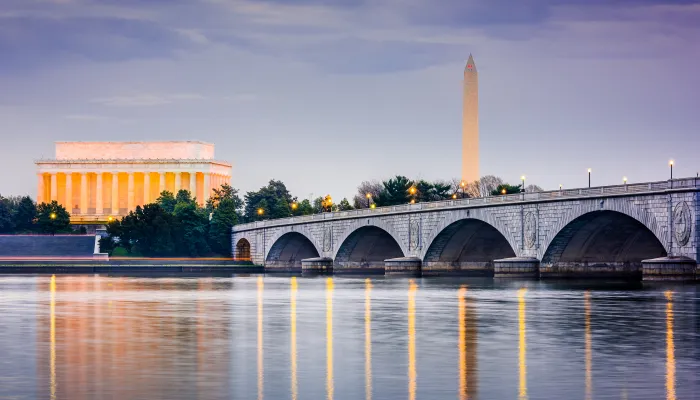Appropriations Watch: FY 2024
Updated 4/24/2024: On Tuesday, April 23, the Senate passed a package of national security-oriented bills passed by the House on Saturday, April 20, that provided supplemental appropriations for Israel, Ukraine, and the Indo-Pacific, as well as a fourth bill that addressed sanctions and other economic concerns. Three of the four bills considered provide a total of roughly $96 billion in budget authority, and the fourth has a minimal fiscal effect. The rule for the four House bills technically sent them to the Senate as an amendment to a previous Senate-passed bill. The President signed the bill on April 24.
On Feb. 13, the Senate passed an amended version of a $95 billion national security supplemental that includes funds for Ukraine, Israel, Taiwan, and operations in the Red Sea. The House had previously passed stand-alone supplemental appropriations last fall, but an alternative $17.6 billion Israel supplemental was defeated under suspension of the rules on Feb. 6.
The Senate cleared a "minibus" full-year appropriations package early in the morning on Saturday, March 23, by a 74-24 vote, for the remaining six appropriations bills that were set to expire on Friday, March 22: Defense, Financial Services-General Government, Homeland Security, Labor-HHS-Education, Legislative Branch, and State-Foreign Operations. The President signed the measure, and the hours-long lapse in funding is not expected to disrupt government operations. The House had passed the measure on Friday, March 22, under suspension of the rules by a 286-134 vote.
On March 8, the Senate cleared, by a 75-22 vote, full-year appropriations for fiscal year 2024 under a first “minibus” for six appropriations bills: Agriculture, Commerce-Justice-Science, Energy-Water, Interior-Environment, Military Construction-VA, and Transportation-HUD. The President signed the measure. The House had passed the minibus under suspension of the rules by a 339-85 vote on March 6.
The fourth continuing resolution for FY 2024, which continued the "laddered" approach from earlier CRs, was designed to allow time for Congress to complete appropriations for the year under an announced agreement. Both sets of appropriations bills that were scheduled to expire under the CR have now been funded through September.
Congressional leaders announced a deal on topline appropriations levels for fiscal year 2024 on Jan. 7. The topline agreement provided for a total of $773 billion in nondefense discretionary spending, including $704 billion in base nondefense spending and $69 billion in side deals, and $886 billion in defense spending.
The new fiscal year began on October 1, and Congress struggled to enact a CR by the end of September to avoid a government shutdown. Supplemental funding for Ukraine, Israel, and border security have also been central to disagreements over appropriations this year. The Biden administration has released supplemental funding requests of $106 billion for national security priorities and $56 billion for domestic programs.
With the enactment of the Fiscal Responsibility Act (FRA), appropriations bills were marked up in the House and Senate in June and July. The FRA caps total base discretionary spending at $1.590 trillion for FY 2024, with base defense spending capped at $886 billion (a 3 percent increase from FY 2023) and base nondefense spending capped at $704 billion (up to a 9 percent decrease from FY 2023, depending on how it is measured).
As we did last year, we'll be tracking the bills as they move from committee to the House and Senate floor and onto the President's desk.
The table below shows the status of each appropriations bill. To learn more about the appropriations process, read our Appropriations 101 paper.
Appropriations will be one of several deadlines Congress will face over the coming months. See a list of the upcoming fiscal deadlines here.
Sources: House Appropriations Committee, Senate Appropriations Committee, Congress.gov. All dates are in 2023 unless noted otherwise.
As we explain in Appropriations 101, the House and Senate Appropriations Committees approve 302(b) spending levels for each subcommittee after the topline 302(a) levels are determined by the Budget Committees. Below is an excerpt (click here to read the full report).
How does Congress determine the total level of appropriations?
After the President submits the Administration’s budget proposal to Congress, the House and Senate Budget Committees are each directed to report a budget resolution that, if passed by their respective chambers, would then be reconciled in a budget conference (to learn more, see Q&A: Everything You Need to Know About a Budget Conference).
The resulting budget resolution, which is a concurrent resolution and therefore not signed by the President, includes what is known as a 302(a) allocation that sets a total amount of money for the Appropriations Committees to spend. For example, the conferenced Fiscal Year (FY) 2016 budget between the House and Senate set the 302(a) limit for that year at $1.017 trillion.
In the absence of a budget resolution, each chamber may enact a deeming resolution that sets the 302(a) allocation for that chamber. Leaders of the House and Senate Budget Committees may propose deeming resolutions at whatever level they find necessary to fund discretionary priorities and to officially set 302(a) allocations for the fiscal year. Deeming resolutions for FY 2024 had been expected to adhere to the $1.590 trillion level included in the Fiscal Responsibility Act, but the House may draft its appropriations bills to the $1.471 trillion level from FY 2022 and set its 302(a) allocations accordingly. In the House, this can be done by a simple majority vote, which is how the FY 2023 deeming resolution passed. However, in the Senate such a resolution does not have privileged consideration, making it vulnerable to a filibuster.
The appropriations process for the current fiscal year, FY 2023, was completed in December 2022. The House adopted a deeming resolution for FY 2023 in June 2022 and passed six appropriations bills over the summer, while the Senate released its bills in late July and passed none before the new fiscal year. Lawmakers ultimately agreed to an FY 2023 omnibus appropriations bill in December 2022 that provided $1.602 trillion in base discretionary spending, an increase of 8.9 percent from comparable FY 2022 level.
How does Congress allocate appropriations?
Once they receive 302(a) allocations, the House and Senate Appropriations Committees set 302(b) allocations to divide total appropriations among the 12 subcommittees dealing with different parts of the budget. The subcommittees then decide how to distribute funds within their 302(b) allocations. The 302(b) allocations are voted on by the respective Appropriations Committees, but they are not subject to review or vote by the full House or Senate. The table below lists the FY 2023 regular (non-emergency) appropriations along with the House and Senate FY 2024 302(b) allocations. The table will be updated as both the House and Senate Appropriations Committees release their 302(b) allocations for FY 2024.
The table below compares actual funding for FY 2023 with the FY 2024 302(b) allocations from the House and Senate.
| Budget Authority Allocations to Appropriations Subcommittees (billions) | |||||
|---|---|---|---|---|---|
| Subcommittee | FY 23 Enacted Level | President's FY 24 Budget | House FY 24 | Senate FY 24 | Final Negotiated FY 24 Level |
| Agriculture | $25.5 | N/A | $17.8 | $26.0 | $26.2 |
| Commerce, Justice, Science** | $82.4 | N/A | $58.7 | $69.6 | $66.5 |
| Defense | $797.7 | N/A | $826.4 | $823.3 | $824.5 |
| Energy and Water Development | $54.0 | N/A | $52.4 | $56.7 | $58.2 |
| Financial Services and General Government** | $27.6 | N/A | $11.3 | $16.8 | $13.7 |
| Homeland Security** | $60.7 | N/A | $62.8 | $56.9 | $61.8 |
| Interior, Environment** | $38.9 | N/A | $25.4 | $37.9 | $38.6 |
| Labor, HHS, Education | $207.4 | N/A | $147.1 | $195.2 | $194.4 |
| Legislative Branch | $6.9 | N/A | $6.7 ($5.3 House-only spending formally approved) | $6.8 | $6.8 |
| Military Construction, VA | $154.2 | N/A | $155.7 | $154.4 | $153.9 |
| State, Foreign Operations** | $59.7 | N/A | $41.4 | $58.4 | $55.8 |
| Transportation, HUD** | $87.3 | N/A | $65.2 | $88.1 | $89.5 |
| Undistributed Changes in Mandatory Programs | N/A | -$30.6* | N/A | N/A | N/A |
| Total, Base Discretionary | $1.602 trillion | $1.695 trillion* | $1.471 trillion^ | $1.590 trillion^ | $1.590 trillion |
Sources: House Appropriations Committee, Senate Appropriations Committee, CBO estimate of Consolidated Appropriations Act, 2024 (first FY 2024 six-bill minibus), CBO estimate of Further Consolidated Appropriations Act, 2024 (second FY 2024 six-bill minibus), CBO estimate of H.R. 2617 (FY 2023 omnibus), Office of Management and Budget
*The President's FY 2024 budget proposes $1.726 trillion in discretionary funding partially offset by $30.6 billion in changes in mandatory spending programs (CHIMPs).
**In addition to base discretionary spending, the two six-bill minibus packages provide for certain adjustments to Fiscal Responsibility Act caps, including $12.5 billion in total emergency spending, $2.65 billion for Interior-Environment for wildfire suppression, and a total of $20.4 billion for disaster relief ($20.261 billion to Homeland Security and $143 million to Financial Services). Emergency spending was distributed as follows: $2 billion for Commerce-Justice-Science, $2.5 billion for State-Foreign Operations, and $8 billion for Transportation-HUD.
^The Senate 302(b) totals reflected the cap as enacted in the Fiscal Responsibility Act; the House originally limited its total to the FY 2022 level. New Senate allocations with emergency spending and other revisions that were filed on September 12 totaled $1.652 trillion and included $36.7 billion for emergency spending, $20.4 billion for disaster relief, and $2.65 billion for wildfire suppression. Emergency spending was distributed as follows: $10.8 billion for Transportation-HUD, $8 billion for Defense, $4.5 billion for Labor=HHS-Education, $4.3 billion for Homeland Security, $3.25 billion for State-Foreign Operations, $2.25 billion for Commerce-Justice-Science, $2.195 billion for Interior-Environment, and $1.365 billion for Energy-Water. Disaster relief spending was allocated to Homeland Security ($20.261 billion) and Financial Services-General Government ($143 million). All $2.65 billion in fire suppression spending was allocated to Interior-Environment.
As Congress considers appropriations bills, it is important that lawmakers avoid budget gimmicks and contemplate the longer-term trajectory of discretionary spending.
If you have any questions about terminology or the appropriations process, please see our Appropriations 101 report, and stay tuned to our blog for continuing coverage.

